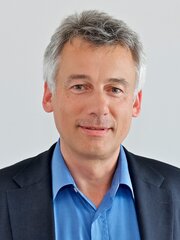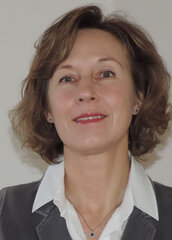|
|
The SLS as you know it is history. Beamline operation ended on Monday this week. The electrons will continue to circulate until Saturday to allow our machine experts to perform beam tests that they would not dare to do between user-operation periods. Then we will pull the plug for good. Dismantling the SLS will begin the same day, 30 September, to make way for an even better ring, SLS 2.0. |

Hans Braun
|
|
The preparations for the new ring have kept the many PSI teams involved in the SLS 2.0 project very busy over the past few years. We are now excited, but also a little nervous, to begin the exchange of the storage ring. Many magnets, vacuum chambers, girders and power supplies are already in storage spaces and measurement labs at PSI. At the same time, the beamline crews are preparing upgrades to existing beamlines and building new stations. On 3 September, the SLS 2.0 pilot beamline PXIII saw first light to perform initial tests, using some of the last photons from the old SLS.
SLS 2.0 will be the third synchrotron light source of the 4th generation in Europe, after MAX IV and ESRF-EBS. ELETTRA and DIAMOND will follow soon thereafter; the latter has just received a positive funding decision from the UK government. And there are more to come. With this ‘generational change’, synchrotron light is entering a new era with many opportunities for better spatial and temporal resolution, faster sample turnover and larger sample sizes. All this is accompanied by a substantial increase in data volume and complexity. So, both challenges and opportunities are great — which is fertile ground for great science.
Hans Braun, Frithjof Nolting and Philip Willmott
On behalf of the SLS 2.0 project |
|
Next proposal submission deadlines
|
|
|
A call for SLS proposals will be announced towards the end of the SLS 2.0 upgrade project. An overview of all proposal submission deadlines of the PSI facilities can be found here.
|
|
Making ‘extreme photolithography’ resistless
|
|
|
SLS — Photon-induced oxide patterning on silicon for resistless EUV lithography
The trend towards ever more compact microchips continues unabated, not least thanks to photolithographic processes that make it possible to produce ever smaller structures. However, as miniaturization continues, the limitations posed by the available photoresists are becoming critical and could eventually limit further progress. A team of researchers working at the XIL-II beamline of SLS has now made important progress towards overcoming this bottleneck. They have demonstrated that extreme ultraviolet (EUV) photolithography — widely used in semiconductor manufacturing for its high resolution and throughput — is feasible even when no photosensitive layer has been applied to the silicon, owing to surface reactions induced by the EUV photons. Performing such resistless EUV lithography on a large scale is an exciting prospect, as the approach overcomes the inherent resolution and roughness limitations of photoresist materials.
|
|
Mystery of microgels solved
|
|
|
SINQ — Measuring the counterion cloud of soft microgels using SANS with contrast variation
The physics of colloids involving hard particles is well understood, but colloids with soft particles hold some startling surprises. An experiment carried out 15 years ago showed that soft particles made of cross-linked polymers, so-called microgels, shrink abruptly when their concentration is increased above a certain threshold. When this happens, large particles contract until they are the size of their smaller neighbours. Amazingly, this happens even when the particles are not actually in contact with each other. The key to understanding this peculiar behaviour relies on the existence of peripheric charged groups and the associated counterion cloud. However, no direct measurement of such clouds existed — until now. A team of researchers has performed at SINQ small-angle neutron scattering (SANS) experiments to directly measure the radius and width of the counterion cloud, thereby confirming its important role for understanding the swelling behaviour of microgels and the phases of microgel suspensions.
|
|
Towards an in-depth understanding of defects
|
|
|
SμS — Defect profiling of oxide–semiconductor interfaces using low-energy muons
The quality of the oxide–semiconductor interface is critical to the performance of semiconductor devices. However, characterizing and understanding defects in this region is challenging. Researchers working at SµS have now established muon spin rotation with low-energy muons (LE-µSR) as a powerful method for probing such interfacial systems. They studied silicon dioxide deposited on silicon and silicon carbide, and compared two different oxide-growth processes, plasma-enhanced chemical vapour deposition (PECVD) and growth by thermal oxidation. In the experiments, the oxide and semiconductor layers could be clearly distinguished, and distinct patterns of structural order were identified for the two growth processes. This ability to resolve structural and electronic properties with nanometre depth resolution provides a unique tool for studying oxide-semiconductor systems — and ultimately for understanding how interfaces with low defect densities can be grown.
|
|
|
SwissFEL & SLS — Tender X-rays show how one of nature’s strongest bonds breaks
Transforming methane, one of the most potent greenhouse gases, and longer-chain alkanes into less harmful and even useful chemicals would remove the threats they pose and provide a huge feedstock for the chemical industry. However, the transformation necessitates as a first step the breaking of a C–H bond, one of the strongest chemical linkages in nature. Forty years ago, molecular metal catalysts were discovered that can easily cleave C–H bonds — all that is needed is a short flash of visible light to ‘switch on’ the catalyst. But how this so-called C–H activation works has remained unknown. Now, in UV-pump and X-ray probe experiments at SwissFEL and SLS, researchers have been able to directly track the charge-transfer interactions during the C–H activation of octane on a femtosecond to nanosecond timescale. Their study provides unprecedented insight into how the catalyst performs its function and might point to ways to manipulate C–H reactivity at metal catalysts.
|
|
An insightful null result
|
|
|
CHRISP — nEDM collaboration sets another limit for axion-like particles
The most sensitive search for a neutron electric dipole moment (nEDM) is conducted by the international nEDM collaboration at CHRISP. In side-analyses, the team has pioneered searches for ultra-light axion-like particles (ALPs), which are theoretically well motivated candidates for dark matter. ALPs could form coherently oscillating fields, couple to the spins of neutrons and nuclei, and thereby give rise to observable modulations of Larmor precession frequencies in electric and magnetic fields. A null result for the present search using a novel analysis method on the 199Hg co-magnetometer data sets now limits for ALPs in the mass range of 10-16 to 10-13 eV. (On a side note, the work is published in SciPost Physics, a two-way open access, not-for-profit journal governed by scientists themselves; the Laboratory for Particle Physics at PSI is one of its sponsors.)
|
|
News from the user facilities
|
|
|
SLS: The SLS 2.0 upgrade is underway
The SLS has been in operation since 2001. Now an upgrade to this large-scale research facility is underway (see also the editorial above). Science, technology, engineering, and data processing have advanced considerably since SLS was first commissioned. The modernization project, called SLS 2.0, will enable novel, better, and more profound research than before. Visit this page to read more about some of the countless efforts involved in this project, and join our beamline scientists as they look back on 22 years of brilliant science at SLS.
|
|
SINQ: First experiments on CAMEA
Over the past two years, the former Rita-II instrument at SINQ has undergone a major upgrade of both the primary and secondary spectrometers. The new CAMEA (Continuous Angle Multi-Energy Analysis) cold-neutron multiplexing spectrometer is now fully operational and has delivered first results. CAMEA is optimized for efficient data acquisition of scattered neutrons in the horizontal scattering plane, so that detailed and rapid mapping of low-energy excitations is possible under extreme sample environment conditions. First experiments exploring the potential of the massive multiplexing triple-axis concept — which allows the simultaneous measurements of much larger regions of reciprocal space compared to Rita-II — have already produced excellent results, leading to several high-quality publications.
|
|
SwissFEL: A compact gas attenuator made by additive manufacturing
For experiments at soft X-ray beamlines such as ATHOS at SwissFEL, it is crucial to be able to vary the intensity of the pulses without having to retune the machine each time. This is achieved by introducing a tunable gas attenuator into the beamline. However, as space is at a premium at the front end of the beamline, an innovative approach was needed to accommodate the space constraints. It turned out that additive manufacturing offered the freedom to realise a compact design, with a triple pumping stage taking up less than half a metre. The ATHOS gas attenuator provides attenuation of three orders of magnitude up to an energy of 1200 eV, with highly stable operation and the ability to change the attenuation continuously — going from maximum attenuation to full beam in about one minute.
|
|
CHRISP: The exact lifetime of a neutron
The ultracold neutron (UCN) source provides UCNs for fundamental physics experiments. In the UCN experimental area West, a team from the Johannes Gutenberg University Mainz (JGU) is currently installing the τSPECT apparatus. Its aim is to provide a precision measurement of the neutron lifetime τ, a quantity that has been the subject of heated debate over the past decade, due to a distinct disagreement between two measurement methods, beam and bottle. The τSPECT apparatus imposes the radial magnetic field of a Halbach octupole on the axial field of two superconducting coils, to form a fully magnetic bottle. The unique single and/or double spin-flip method for bottle loading has already been demonstrated at the UCN source of the JGU research reactor TRIGA. The high UCN intensity available at PSI should now enable a highly competitive measurement precision in the low sub-second range that can contribute to the solution of the neutron-lifetime puzzle. ‘Beam on’ is scheduled to take place within the next few days.
|
|
JUSAP - The Joint Users Association
|
|
|
Are you motivated to develop materials for the circular economy? The ReMade@ARI project (Recyclable Materials Development at Analytical Research Infrastructures) has launched three calls for proposals, addressing scientists, small and medium-sized enterprises (SMEs) and industry, respectively: ReMade-TNA, ReMade-SME and ReMade-IND.
As a hub dedicated to developing new materials for a circular economy, ReMade@ARI provides |

Joanna Hoszowska
|
|
coordinated access to more than 50 European analytical research infrastructures for scientists exploring the properties and structures of recyclable materials.
Please consider taking advantage of the state-of-the-art characterization techniques of the Analytical Research Infrastructures in Europe (ARIE). Users are invited to submit proposals, which should address scientific or industrial challenges related to the development of materials used in the context of the circular economy, such as plastics, food, water and nutrients, electronics and ICT, textiles, packaging, construction and buildings, and batteries and vehicles.
A visual overview of the services and user access guidelines here. Also, have a look at the success story of the 1st ReMade-TransNational Access (TNA) call for proposals (Spring 2023) here.
We encourage all members of the PSI user community to contact us with any issues relating to user operations at PSI.
Yours sincerely,
Joanna Hoszowska
On behalf of the JUSAP committee |
|
|
|